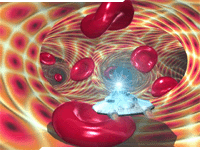Biotech Futures
The Mapping of the Human Genome is just the beginning. Genomics, bioinformatics, Systems-Biology and Proteomics will transform biotech into a evolutionary design science affecting everything from health care to agriculture. Human performance enhancement will be the largest market in the 21st century.
 Synthetic tissue and organisms, “friendly” biobots and bio-nanites, cybernetic enhancements, cellular “repair” systems and biochip implants . . . these are just a few of the applications already being developed.
Synthetic tissue and organisms, “friendly” biobots and bio-nanites, cybernetic enhancements, cellular “repair” systems and biochip implants . . . these are just a few of the applications already being developed.
Molecular repair nanite
here, in this visualization, a bio-nanite travels down the axon of a nerve cell, to re-construct insulating layer that has been damaged due to neurological disease.
Synthetic tissue systems, cellular manifolds, hybrid biologicals utilized for organ prosthetics, tissue replace-ment, and many other applications.
The “hardware” of modern genomics, in which “probes” of DNA are bonded to the surface of a biochip. When DNA from a sample material is “querried” by the ap-propriate receptor probes on the chip’s surface, a hybridyzation event occurs, which can be optically detected to signify the presence of a precise “genetic marker”. The example shown here is the GeneChip developed by Affymetrix.
 The “wheel of life”, in the form of a proteomic schematic, is the blueprint from which new geno-pharmacopia solutions are being derived, eventually to provide solutions to virtually all known diseases, perhaps even aging itself.
The “wheel of life”, in the form of a proteomic schematic, is the blueprint from which new geno-pharmacopia solutions are being derived, eventually to provide solutions to virtually all known diseases, perhaps even aging itself.
Neural prosthetics, implantable biochips, cybernetic enhancement micro-devices . . . this was the stuff of science fiction even just a few years ago, but is already in production, and being provided in various forms to patients. The example shown here is from a line of products being developed and marketed by Medtronics. They are currently producing a variety of devices, including neural implants to treat the effects of epilpsy, and other neurological disorders.
 Dendrimers, protein – like molecules which can be used in a remarkable variety of ways to mimic the behavior of proteins. Applications ranging from cellular targeting and delivery systems to “smart” bioprobes are well into development.
Dendrimers, protein – like molecules which can be used in a remarkable variety of ways to mimic the behavior of proteins. Applications ranging from cellular targeting and delivery systems to “smart” bioprobes are well into development.
Where does current research and development go from here? Advanced sensory and neural enhancement devices, neural interconnect systems, micro and nano scale machines that patrol the human body constantly repairing and updating various organs, blood, tissue systems . . . this is just the beginning.
The ribosome, the nanofoundary of all living cells . . . here in its natural form, is being probed, and eventually will be hybrid engineered as the nanobiological machinery of creation.
The “software” of biotech – protein Recombinant proteomics, the ability to synthesize and construct proteins on demand, to configure with any cellular system, any organism, as the messengers and instruction sets for all living things, current, and yet to be created.
This is what is coming.